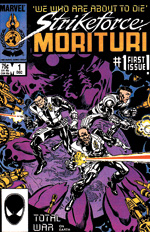 |
|
|
The only good hero Why comic creator Peter B. Gillis, AB’73, AM’80, killed his champions. In the early 21st century, Earth is beset by the Horde, a technologically advanced alien race intent on plundering the planet. The world government, in a desperate attempt at defense, engineers an elite group of superheroes. The catch? Their new powers kill them within a year.
The premise of Strikeforce: Morituri, the Marvel comic that introduced this doomed group in the 1980s, emerged after Supergirl’s death in DC Comics’s Crisis on Infinite Earths, says creator Peter B. Gillis, AB’73, AM’80. “It just didn’t work for me,” along with other comic heroes’ “bogus” deaths. “They always come back—they were alien energy replicas, alternate dimensions, clones, you name it.” A comic book afficionado, Gillis, 52, had grown up with the genre. Some of his favorite titles were DC’s Mystery in Space and Marvel’s Fantastic Four, Thor, and Strange Tales. He was “a complete Marvelite,” he recalls, and Marvel cofounders Stan Lee and Jack Kirby “were my spiritual fathers.” Decades later, when Gillis was doing graduate work in medieval German literature, he found himself stranded on “the Beckett-like plains of All But Dissertation.” He took a leave of absence from academia—“I didn’t exactly quit; I just started devoting less time to the damn thesis and more time to funny books”—and moved back with his parents in New York to pursue his childhood passion. He “shoved scripts in people’s faces for about nine months,” and though he was spurned at first, a changing of the guard at Marvel led to a Captain America assignment. “And the rest, as they say, is mythology.” During his 13-year comic-book career, Gillis, who now owns his own graphics company, penned numerous Marvel titles, including Dr. Strange, What If, Hulk, The Defenders, several DC titles, and First Comics’s Shatter. Published in 1986, Shatter was the first comic illustrated on a computer—an Apple Mac—by artist Mike Saenz, and printed on a dot-matrix printer. The Atlantic Monthly and USA Today covered the project. “From a 2004 standpoint, it’s trivial, but this is before the days of PageMaker,” says Gillis. “It was a big success at a time when I needed a big success.” But among comic fans Gillis remains best known for Morituri, which ran for 31 issues—20 created by Gillis and collaborator Brent Anderson—between 1986 and ’89. Since then Morituri, Latin for “we who are about to die,” has achieved something of a cult following. Avoiding the back-from-the-dead clichés, Gillis says, reinstituted the genre’s drama. “The only way, I thought, to really bring death and, therefore, heroism back into comics was to make it deeply part of the premise.” The unique plotline forced Gillis and Anderson to create many diverse characters to replace those who opened the series. His favorites were Aline Pagrovna, a.k.a. Blackthorn, and Jelene Anderson, a.k.a. Adept, two female members of the strikeforce. Blackthorn, who could disrupt molecular bonds, causing objects to melt and break, “had some of the best moments in the book,” Gillis says. “Which is partly why I killed her last—sort of a Hannibal Lecter thing to say, isn’t it? But I had a real soft spot for Adept,” who had great powers of analysis, “since she was the first fundamentalist Christian character to be portrayed positively for as long as I can remember.” (Gillis himself is “about as non-fundamentalist-Christian as you can get.”) “She really was wonderful,” he continues, “if not easy to write. And I think her death came off beautifully.” (She died returning with the team from a trip to Jupiter’s neighborhood.) All of the characters, Gillis says, had “a deeply sympathetic humanity...which is perilous if you know they’re doomed.” That tension, generated when the story “violates superhero conventions—death is real and you don’t come back,” gave Morituri its narrative power. In the mid-1990s Marvel tried to revive the series, which still garners the occasional mention in industry magazines. And in late 2002 it was optioned for a Sci Fi Channel series called A Thousand Days, which gives the characters 1,000 days before their super-powers kill them. Negotiations are ongoing. Unlike its namesake heroes, it seems, Morituri refuses to die.—Kurt Anthony Krug |
|
phone: 773/702-2163 | fax: 773/702-8836 | uchicago-magazine@uchicago.edu

 Arts
& Letters
Arts
& Letters